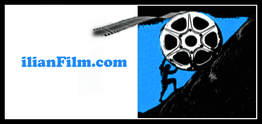| The first to use wide screen was Abel Gance in his 1927 film, Napoleon. This 6 hour biopic finishes with a twenty minute sequence in which 3 images are combined across 3 screens. In 1952, CINERAMA was introduced, which pretty much copied the same idea. Three cameras were linked and synchronized together recording the action at the same time. In the exhibition stage, 3 linked projectors were |
used for the screening of the film.
This image was six times bigger than the regular image at the time. Cinerama developed their method and in 1963 they introduced a single lens for the widescreen system. The first film to show the result was in 1963, It’s a Mad, Mad, Mad, Mad World, directed by Stanley Kramer. The film was a great success at the time and audiences fled to theaters to see it. This success was much needed in Hollywood, because theater attendance was slipping since the Second world war.
Cinerama was not the only system used for wide screen. In 1953 Henry Foster directed a film called, The Robe, which was the first film to be released in CinemaScope. CinemaScope uses an anamorphic lens, which ‘squeezes” the image onto normal 35mm film. Then another lens was needed in projection to “un-squeeze” the image for the desired effect. Cinemascope thus altered the standard aspect ratio to 2.35:1, up to then the regular aspect ratio was 4:3. As a norm in the technological realm, the craze was not long lived.
In 1960, Panavison came to life with the variable prismatic lens which produced an image with almost no distortion compared to anamorphic films. This was the blow to Cinemascope and gradually Panavison prevailed.
Another Hollywood studio, Paramount, developed their own widescreen system, which they called Vista Vision. Vista Vision used a process which allowed the regular 35mm film to run horizontally in the camera, not vertically, which was the norm until now. Thus Paramount was able to choose their aspect ratio. The aspect ratio could vary between 1.33:1 and 1.96:1.
Another system was used in the 1955 film, Oklahoma (directed by Fred Zinnemann), where the film was shot with 70mm film, twice the size of the regular 35mm film strip. The downside was that everything costs twice as much for the 35mm film and thus the system was used only for blockbuster projects. Some claim that the “Blockbuster” emerged at the same time, mid 1950s, with the release of a few films - The Ten Commandments (Dir. C.B.DeMille), War and Peace (Dir. King Vidor) and Around The World in 80 Days (Dir. Michael Anderson). There are earlier films that bare the same mark. In 1913 Quo Vadis, directed by Enrico Guzzzoni, was released in Italy. Two years later, in 1915, The Birth of a Nation was released, directed by D.W.Griffith. Both of these films are over 2 hours long, with huge budgets, and thousands of extras. The reason I’m talking about blockbusters, is because widescreen took second stage in the 1950s and priority was given to the new ‘Monster” - the blockbuster.
This image was six times bigger than the regular image at the time. Cinerama developed their method and in 1963 they introduced a single lens for the widescreen system. The first film to show the result was in 1963, It’s a Mad, Mad, Mad, Mad World, directed by Stanley Kramer. The film was a great success at the time and audiences fled to theaters to see it. This success was much needed in Hollywood, because theater attendance was slipping since the Second world war.
Cinerama was not the only system used for wide screen. In 1953 Henry Foster directed a film called, The Robe, which was the first film to be released in CinemaScope. CinemaScope uses an anamorphic lens, which ‘squeezes” the image onto normal 35mm film. Then another lens was needed in projection to “un-squeeze” the image for the desired effect. Cinemascope thus altered the standard aspect ratio to 2.35:1, up to then the regular aspect ratio was 4:3. As a norm in the technological realm, the craze was not long lived.
In 1960, Panavison came to life with the variable prismatic lens which produced an image with almost no distortion compared to anamorphic films. This was the blow to Cinemascope and gradually Panavison prevailed.
Another Hollywood studio, Paramount, developed their own widescreen system, which they called Vista Vision. Vista Vision used a process which allowed the regular 35mm film to run horizontally in the camera, not vertically, which was the norm until now. Thus Paramount was able to choose their aspect ratio. The aspect ratio could vary between 1.33:1 and 1.96:1.
Another system was used in the 1955 film, Oklahoma (directed by Fred Zinnemann), where the film was shot with 70mm film, twice the size of the regular 35mm film strip. The downside was that everything costs twice as much for the 35mm film and thus the system was used only for blockbuster projects. Some claim that the “Blockbuster” emerged at the same time, mid 1950s, with the release of a few films - The Ten Commandments (Dir. C.B.DeMille), War and Peace (Dir. King Vidor) and Around The World in 80 Days (Dir. Michael Anderson). There are earlier films that bare the same mark. In 1913 Quo Vadis, directed by Enrico Guzzzoni, was released in Italy. Two years later, in 1915, The Birth of a Nation was released, directed by D.W.Griffith. Both of these films are over 2 hours long, with huge budgets, and thousands of extras. The reason I’m talking about blockbusters, is because widescreen took second stage in the 1950s and priority was given to the new ‘Monster” - the blockbuster.

 RSS Feed
RSS Feed